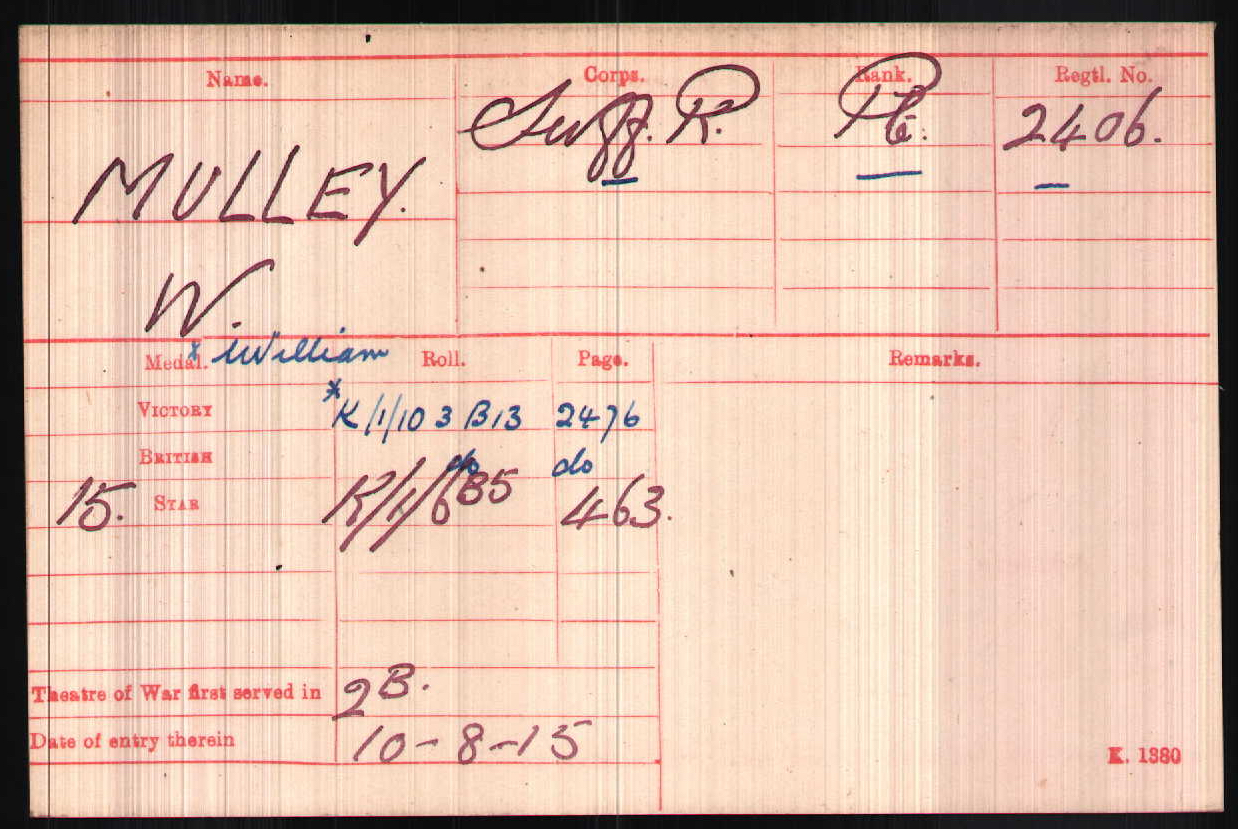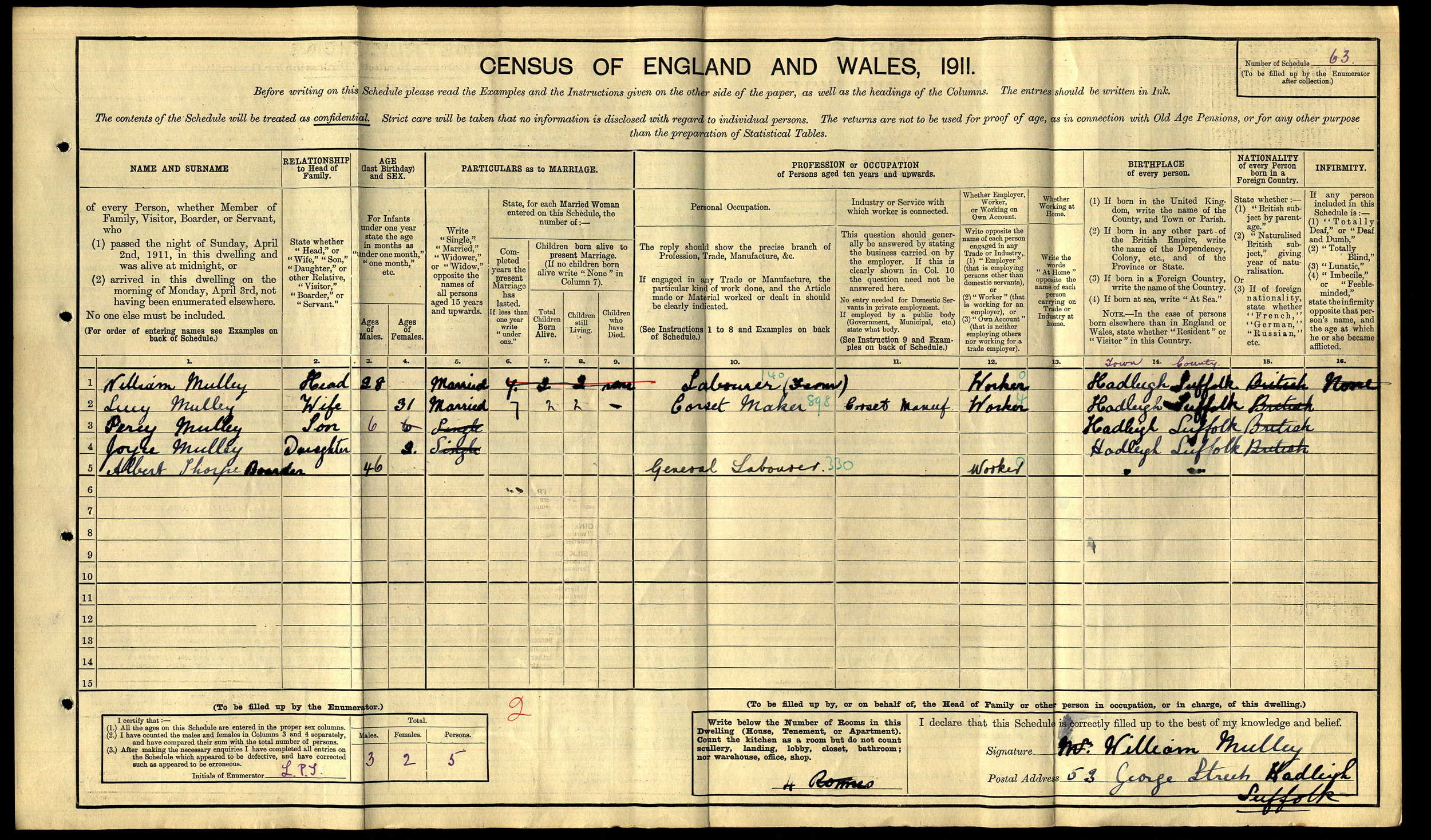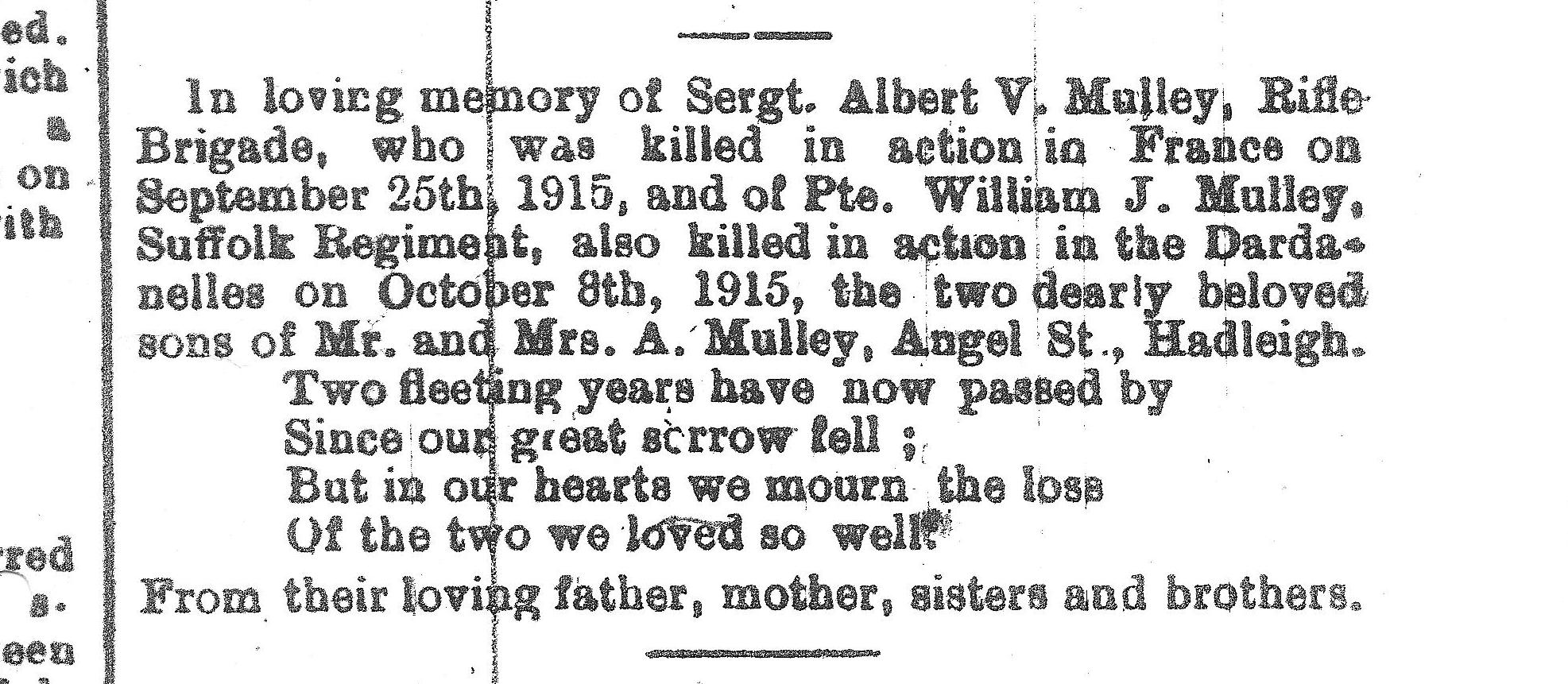William Mulley
Rank: Private
Service Number: 2406
Date of Birth: 1882
Regiment: Suffolk Regiment
Date of Death: 8 October 1915
Age at death: 33
Cemetery: Hill 60 Cemetery
Country: Gallipoli, Turkey
Grave / Reference: II. E. 5
Relatives: Husband of Lucy Mulley
Address: 53 George Street, Hadleigh.
William Mulley's story is one of a double family tragedy. Sadly he and his younger brother Albert, were both killed in action within a few weeks of each other. Albert's story is also told on this website. William was born in Hadleigh in 1882. The 1901 census has him living at home at Place Farm with his parents; Arthur and Eliza Mulley and his siblings; Herbert (16), Albert (14), Frederick (12), Eva (10), Lily (9), Ive (6), Harry (4) and Edwin (2).
By the time of the 1911 census, William, who was employed as a farm labourer, had married Lucy and the couple were living with their two children; Percy (6) and Joyce (2) at 53 George Street, Hadleigh
Private William Mulley.
William Mulley's Medal Index Card
We are not exactly sure when William enlisted, but going by his regimental number we believe it was between September and October 1914. During this period, around 400 men enlisted in response to the outbreak of the war. We know that the local territorial unit, the 1/5th Suffolks were mobilised on the night of the 4/5 August.
Once mobilised the 1st/5th Suffolks spent a number of months carrying out home service tasks. At that time territorial units were liable for home service only and were not required to deploy overseas. However, when it became apparent that more troops would be needed for overseas service, the men of the battalion were asked to volunteer. After giving this some serious thought, 72% of the men volunteered and the battalion was redesigned 1st/5th Suffolk Regiment. Those who opted to stay on home service duties only, became the 2nd/5th Suffolks.
The 1st/5th Suffolks completed their training and preparation and were re-equipped for service in the eastern theatre. They embarked along with the rest of 163 Brigade and the 54 Eastern Division at the end of July from Liverpool bound for Gallipoli.
They arrived and went ashore at Suvla Bay on 10th August 1915 and were quickly moved forward and by midday on the 12th were manning the forward trenches on the Anafarta Plain. At 4pm they were ordered forward as part of a 163 Brigade operation to clear the Plain of snipers in preparation for a much larger Divisional operation that was planned for the following day. The battalion was on the left of the brigade line and 'A' Company made up of Hadleigh men were in the first wave. There was at least 75 Hadleigh men involved and this was a true baptism of fire. They were told it would be a straight forward advance to mop up the odd sniper, but in reality they faced a determined and ruthless enemy. The enemies intimate knowledge of the ground was key. They sniped the Suffolks who could not see the firing points and even if they could, they had no artillery support to combat the snipers. In addition, the Turks made best use of their own artillery which ultimately halted the brigades advance. The Suffolks fell back to a shallow river bed / ditch where they formed the new front line.
The landing beach at Suvla Bay.
The whereabouts of Wiiliam's medals is currently unknown, however his medal index card states that he was entitled to the above three medals.
Remnants of a Lighter used to ferry men ashore at Suvla Bay
On that day, at least 16 men from Hadleigh were killed. Due to the nature of the fighting, their bodies were never recovered from the battlefield until the early 1920s. By then the remains were unrecognisable and could not be identified. The remains were most likely buried in Azmak Commonwealth War Grave Commission cemetery in an unmarked grave. This cemetery is in the area were the Suffolks held the front line. Their names are commemorated on the impressive Helles Memorial which stands on the southern tip of the Gallipoli peninsular. We believe that William took part in this battle and survived.
Sketched trench map showing the trenches around Hill 60.
William's was originally buried near to 'Norfolk Street' trenches, close to were he was killed. After the war the Commonwealth War Graves Commission constructed Hill 60 Cemetery and the 42 graves from the 'Norfolk Street' site were re-located into the new cemetery. William now lies in the corner of this very peaceful and remote cemetery.
William's headstone
After the tragic events of mid August, the 1/5th Suffolks had been moved 4 miles to the south and by September they were in ‘Norfolk Street’ trenches on Hill 60. This was a key piece of ground on the rising slopes and was critical to the Allies as it overlooked the Australians and New Zealanders in Anzac Cove. The Suffolks were now severely depleted, at one point down to a quarter of their original strength. They had to endure horrendous conditions with flies during the heat of the day, vermin at night and water that was not fit to drink. Dysentery and diarrhoea were rampant and shell fire continued day and night. There was slight improvement by mid October as the weather began to cool. It was here on 8 October that Private William Mulley of Hadleigh lost his life.
Hill 60 cemetery
After the war the Commonwealth War Graves Commission constructed Hill 60 Cemetery and the 42 graves from the 'Norfolk Street' site were re-located into the new cemetery. William now lies in the corner of this very peaceful and remote cemetery.
In Memoriam - posted in the Suffolk Free Press of 10 October 1917



























